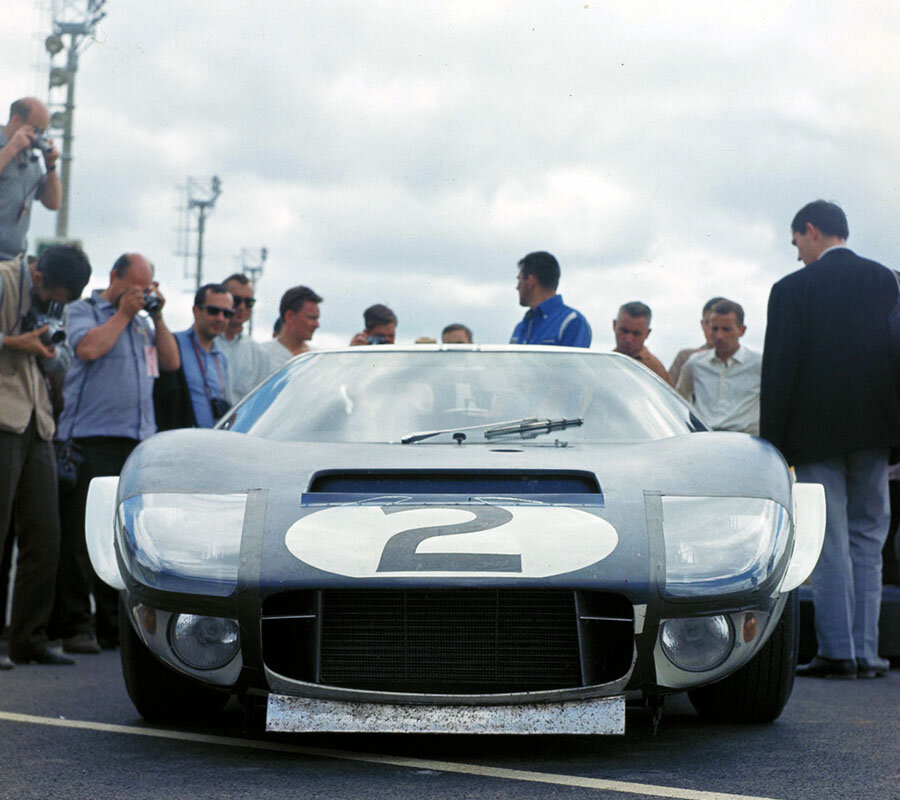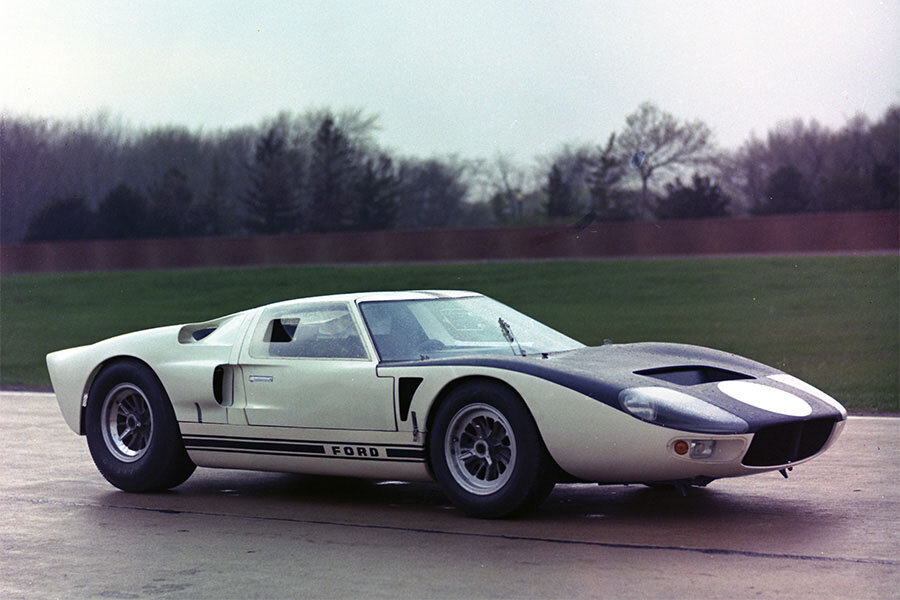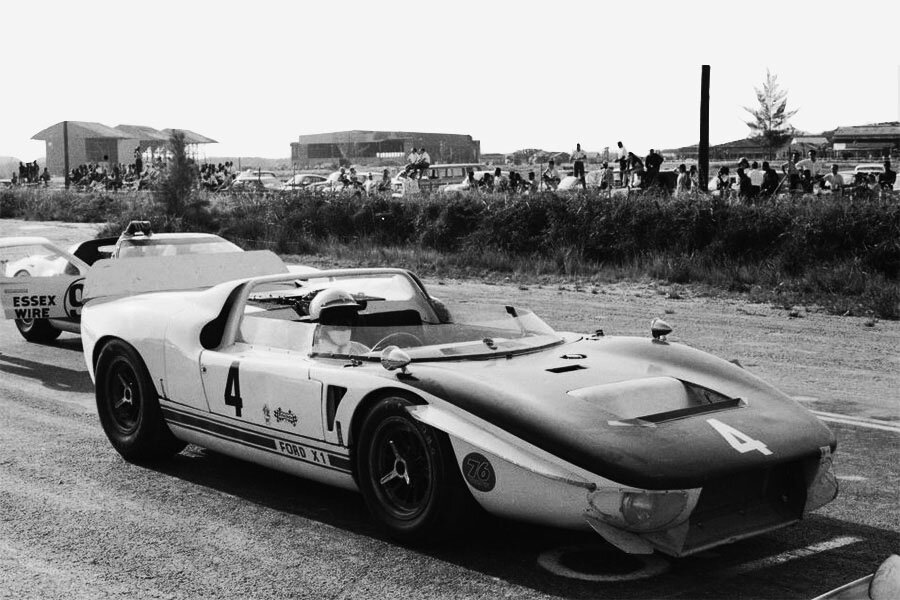Guide: Ford GT40 Prototype Mk2 - a Historical & Technical Appraisal
/BACKGROUND
Although Ford’s limited 1964 campaign with the GT40 proved a major disappointment in terms of results, it was perhaps more important that the fledgling model had demonstrated the kind of speed required to win at international level.
For 1965, investment was ramped up to another level.
At the end of 1964, a new American subsidiary, Kar Kraft, was established to get things done quickly for the parent company’s various racing activities. GT40 designer, Roy Lunn, was installed as its head.
To assist Kar Kraft and Ford Advanced Vehicles in England (FAV), Shelby American were also brought into the fold. The Californian team would help with some much-needed development and also undertook most of the works racing programme in 1965.
Kar Kraft were given two major tasks: shoehorn a competition version of Ford’s seven-litre Galaxie engine into the GT40 and develop a gearbox capable of handling its massive power and torque.
The seven-litre GT40 was christened Mk2. A pair of Mk2 Prototypes were assembled on chassis 106 and 107, but they would race only once: at the 1965 Le Mans 24 Hours.
The high speed nature of the Le Mans circuit with its extremely long straights meant weight and handling were less important than at most other tracks.
After Le Mans, Ford commissioned Bruce McLaren Motor Racing to assemble a third Mk2 Prototype; a super lightweight cut-down roadster known as the X1. Built on chassis 110 X1, this third experimental seven-litre GT40 had a host of technical upgrades. It was raced at Mosport, Riverside and the Bahamas Speed Week.
Construction of the first Mk2 Prototype started in March 1965. At this stage, no thought was given to running the car at Le Mans that year.
ENGINE / TRANSMISSION
The Mk2 Prototype was fitted with a dry-sumped version of Ford’s 427 cubic-inch pushrod 90° V8. Like the 289, it featured an iron block and heads.
Displacement was 6998cc thanks to a bore and stroke of 108mm and 96mm respectively.
Compression was 10.5:1 and a single Holley 780 CFM four-barrel carburettor was fitted.
Peak output was 485bhp at 6200rpm and 475lb-ft at 5000rpm. This compared to around 400bhp and 330lb-ft for the most potent 4.7-litre derivative.
Transmission was via Kar Kraft’s new T44 four-speed manual gearbox, a triple-plate Borg & Beck clutch and limited-slip differential.
CHASSIS
To accommodate the hulking seven-litre engine, Kar Kraft fitted a new rear subframe and made several modifications to the GT40’s steel semi-monocoque chassis.
Suspension was once again via double wishbones at the front with dual trailing links, transverse top arms and inverted lower wishbones at the rear. Coil springs with adjustable dampers were fitted all round along with anti-roll bars at either end.
Spring rates were altered to reflect the Mk2’s considerable extra weight.
Girling supplied their latest ventilated discs brakes for the project.
Rather than use Borrani wire wheels, Ford switched to cast magnesium alloys. These centre-lock Halibrand rims retained the original 15-inch diameter, but were much wider: up from 6.5 to 9.75-inches at the front and from 8 to 12.8-inches at the back.
They came shod with the latest Goodyear tyres which proved a considerable step forward over the original Dunlops.
BODYWORK
Completely new front and rear body panels were designed. The nose was dramatically extended for aerodynamic reasons and also to accommodate bigger radiators with more ductwork.
To increase downforce, canards were mounted on each corner and a discrete chin spoiler was added.
Another spoiler was fitted at the back behind two enormous vertical fins designed to improve high speed stability.
The tail fascia was opened up and fitted with a full width mesh grille to aid cooling.
Additional intakes were mounted on each sail panel.
While by no means a thing of beauty, the 1965 Mk2 Prototype looked like it was doing 200mph standing still.
WEIGHT / PERFORMANCE
Because of the new engine and various reinforcements, weight rose from around 940kg to 1111kg.
A top speed in the region of 215mph was anticipated.
TESTING
With the first car (chassis 106) Ken Miles lapped Ford’s five mile oval track at Romeo, Michigan, at 201mph. This initial performance was so promising that somebody high up decided the Mk2 should head to Le Mans.
However, time was tight and the Mk2 had already missed the annual Test weekend held over April 10th and 11th where Ferrari had gone fastest with their latest 330 P2.
FAV and Shelby had attended with a trio of Mk1 Prototypes that were typically a couple of seconds per lap slower than the best Ferrari had to offer.
Confident the brawny Mk2 could overcome the deficit, Ford entered a brace of cars for the 1965 24 Hours to be held over June 19th and 20th.
1965 LE MANS 24 HOURS
The second seven-litre prototype (chassis 107) wasn’t finished until just before the race. This brand new car was driven by Chris Amon and Phil Hill. The original (chassis 106) was allocated to Bruce McLaren and Ken Miles. Both entries would be managed by Shelby American.
Four other GT40s were also entered. Three of these were very early production Mk1s, one of which was from FAV and two from Shelby (but run under the auspices of Rob Walker and Scuderia Filipinetti). The fourth was a Mk1 Prototype Roadster campaigned by Ford France.
During the week-long build up to the race, the Mk2 Prototypes stood out as the fastest cars ever seen at Le Mans. Phil Hill clocked 213mph down the Mulsanne Straight and set a new lap record at an average speed of 138mph. This was an astonishing 11.7 seconds quicker than his record from the 1964 event.
Qualifying times saw Amon / Hill take pole. Their Mk2 GT40 went 3.1 seconds faster than the Ferrari 330 P2 of John Surtees / Ludovico Scarfiotti.
Third was the Shelby ‘Rob Walker’ Mk1 of Bob Bondurant / Umberto Maglioli with McLaren / Miles fourth in the second Mk2 Prototype.
The Shelby ‘Filipinetti’ Mk1 driven by Ronnie Bucknum / Herbert Muller started fifth. FAV’s Mk1 qualified tenth and the Ford France Prototype Roadster was 13th.
With four GT40s starting in the top five, Ford certainly had the pace to win. There was still a big question mark over reliability though. Earlier in the year, Shelby had won the Daytona 2000km and taken second at Sebring (both with Mk1 Prototypes), but Le Mans was by far the hardest race on the calendar.
Amon’s Mk2 was away first followed by Bondurant’s blue Mk1 and McLaren in the second seven-litre car. Jo Siffert’s Maserati 151 and Ireland in the pale green FAV Mk1 followed.
John Surtees’ Ferrari then stormed up the order and, at the end of lap one, McLaren, Amon and Surtees were first, second and third.
During these early stages, the Mk2 GT40s were five seconds a lap faster than anything else and had soon built a substantial lead.
With an hour gone, the seven-litre Fords were still lying first and second with Surtees third in the Ferrari.
However, when Amon came in to hand over the second placed car to Hill, the Ford was stationary for an extended period. It was rumoured all was not well with the gearbox and Phil Hill rejoined well down the order.
At the two hour mark, the Mk2 of McLaren / Miles had a 22 second lead over Surtees / Scarfiotti, More Ferraris were third, fourth, fifth and sixth as the Ford challenge began to wilt.
By 7pm (three hours in), Ford had lost the lead owing to heavy fuel consumption and three of the Mk1s were already out of the race. Miles and McLaren were down in sixth position and the sister Mk2 Prototype of Amon / Hill was back in the pits with more gearbox trouble.
Half an hour later, Miles / McLaren were out of the race (gearbox) and any realistic hope of victory was over.
Phil Hill did rejoin for another couple of hours and set some very fast times (including that new lap record) but the big Ford was retired soon after 9:30pm with another broken gearbox.
None of the other GT40s managed to finish either and, for the second year running, Ford’s Le Mans campaign had proven a major disappointment. To make matters worse, although the works Ferraris had failed as well, their customer teams swept the top three positions.
Despite this failure, Roy Lunn was more convinced than ever that the big seven-litre engine cruising round at 6000rpm was the way to go if Ford were to win at Le Mans.
Neither of the Mk2 Prototypes used at Le Mans (chassis 106 and 107) ever raced again.
MK2 PROTOTYPE X1 ROADSTER
As part of the development programme for 1966, Ford immediately sanctioned the construction of a highly experimental seven-litre GT40 Roadster to contest a handful of races between late September and early December.
Although FAV had already produced some Mk1 Prototype Roadsters, this new machine was an altogether different proposition.
Abbey Panels in Coventry were commissioned to fabricate a super lightweight aluminium version of the semi-monocoque chassis. Bruce McLaren Motor Racing in Feltham were then given the task of assembly and preparation.
Ford wanted the new machine (chassis 110 X) to be as light as possible, so every component was carefully evaluated and replaced where possible.
At 862kg, the finished car was 250kg lighter than the Mk2s that ran at Le Mans.
Essentially an aluminium-chassis’d Mk2 Prototype with low profile cockpit and Hewland LG500 gearbox, upon completion, the X1 Roadster was flown across the Atlantic for a handful of late season events.
1965 CANADIAN GP
The X1 Roadster first raced in the Canadian Grand Prix at Mosport Park on September 25th 1965.
This was the final round of the Canadian Sportscar Championship and the race was open to what would (from 1966) become known as Group 7 machinery. The presence of tube-framed sprint-type cars with enormous big block motors meant the X1 Roadster was at an immediate disadvantage.
Nevertheless, in the hands of Chris Amon, it qualified a very respectable fourth behind Bruce McLaren’s Oldsmobile-powered McLaren M1B (pole), the Lola T70 Mk1 Chevrolet of David Hobbs (second) and Pedro Rodriguez in a cut-down NART Ferrari 365 P2 Spyder.
Unfortunately, Amon did not finish the 100 lap race after the X1 overheated.
Jim Hall’s rapid Chaparral 2A Chevrolet won from the back of the grid after it had failed to set a time in practice.
1965 LOS ANGELES TIMES GP, RIVERSIDE
Next up was the Los Angeles Times Grand Prix on October 31st.
This 200 mile race at the Riverside circuit in California offered the biggest prize fund in sports car racing. A $15,000 cheque was on offer to the winner and, with generous starting money, the event unsurprisingly attracted a stellar entry.
In the face of stiff opposition, Amon qualified the comparatively heavy X1 Roadster outside the top ten.
Nevertheless, this event garnered its best result: fifth overall.
Victory went to the Chaparral 2A of Hap Sharp. Jim Clark was second in a Ford-powered Lotus 40. Bruce McLaren took the final podium position in his McLaren M2 and Charlie Hayes was fourth in an older M1 variant (both of which ran Oldsmobile motors).
1965 BAHAMAS SPEED WEEK
Ford’s X1 Roadster made its final competitive appearance during the lucrative end-of-season Bahamas Speed Week. It was entered for the Governor's Trophy on December 3rd which was a 25 lap race for sports, GT and touring cars.
Although classified 17th, Amon retired on lap 20 with a broken final drive while lying third.
Bruce McLaren finally got the better of Chaparral and beat Hap Sharp into second place with his McLaren M2 to claim a well earned and extremely profitable victory.
SUBSEQUENT HISTORY
From Nassau, the X1 Roadster was shipped to California where it was handed over to Shelby for assessment.
It was then sent to Kar Kraft in Dearborn and modified to trial a mixture of development parts including a two-speed automatic gearbox.
Once this work was complete, chassis 110 X was kitted out as a 1966-spec. Mk2 Roadster.
Newly configured, it went on to win the 1966 Sebring 12 Hours driven by Ken Miles and Lloyd Ruby.
Text copyright: Supercar Nostalgia
Photo copyright: Ford - https://www.ford.com



































